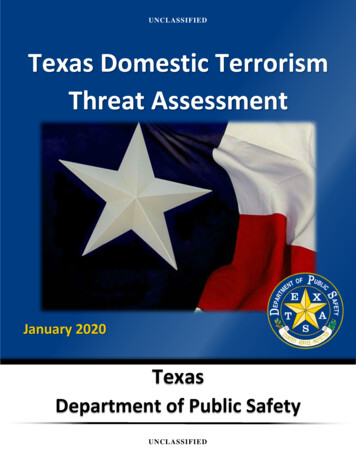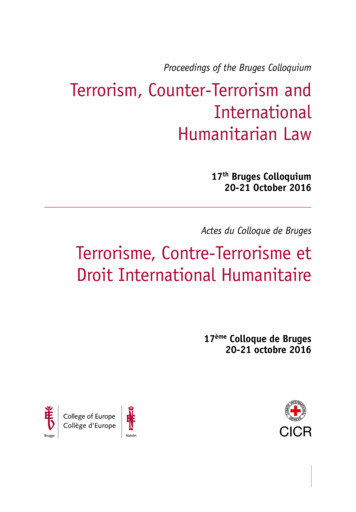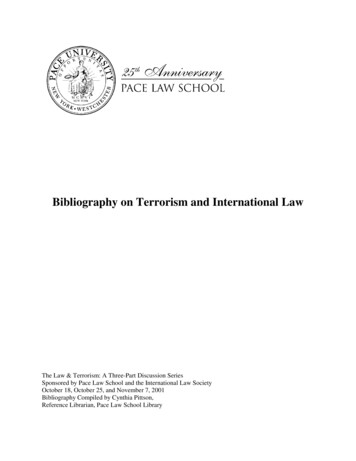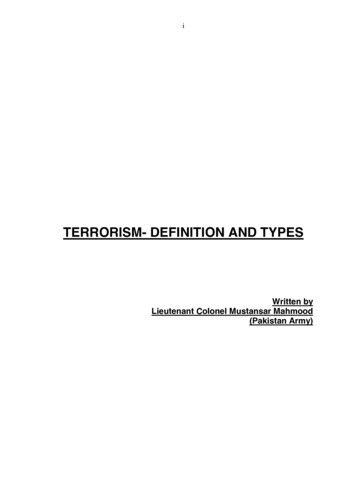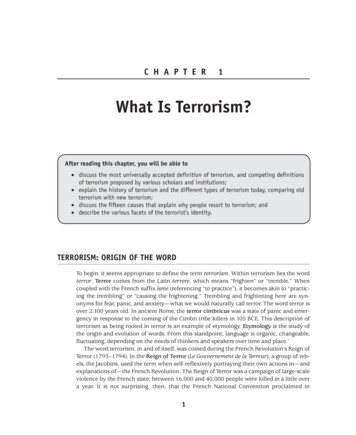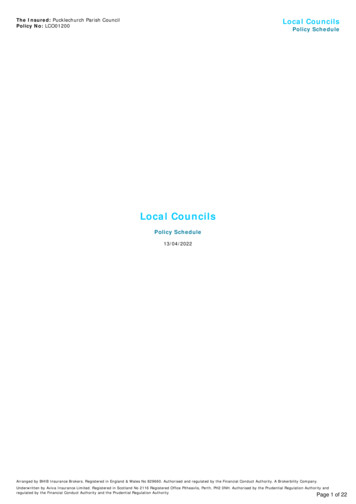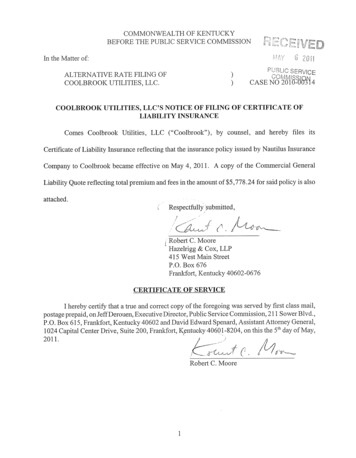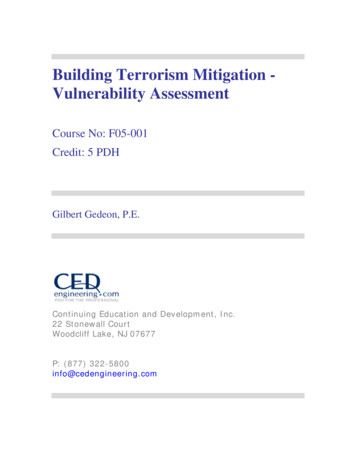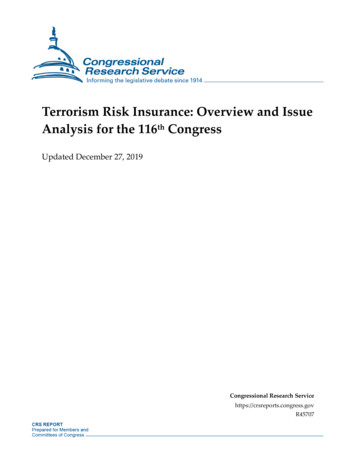
Transcription
Terrorism Risk Insurance: Overview and IssueAnalysis for the 116th CongressUpdated December 27, 2019Congressional Research Servicehttps://crsreports.congress.govR45707
SUMMARYTerrorism Risk Insurance: Overview and IssueAnalysis for the 116th CongressR45707December 27, 2019Baird WebelSpecialist in FinancialPrior to the September 11, 2001, terrorist attacks, coverage for losses from such attacksEconomicswas normally included in general insurance policies without additional cost to thepolicyholders. Following the attacks, such coverage became expensive, if offered at all.Some observers feared the absence of insurance against terrorism loss would have awider economic impact, because insurance is required to consummate a variety oftransactions (e.g., real estate). For example, if real estate deals were not completed due to lack of insurance, thiscould have ripple effects—such as job loss—on related industries. Terrorism insurance was largely unavailable formost of 2002, and some have argued that this adversely affected parts of the economy; others suggest the evidenceis inconclusive.Congress responded to the disruption in the insurance market with the Terrorism Risk Insurance Act of 2002(TRIA; P.L. 107-297), which created a temporary three-year Terrorism Insurance Program. Under TRIA, thegovernment would share the losses on commercial property and casualty insurance should a foreign terroristattack occur, with potential recoupment of this loss sharing after the fact. TRIA requires insurers to maketerrorism coverage available to commercial policyholders but does not require policyholders to purchase thecoverage. The program expiration date was extended in 2005 (P.L. 109-144), 2007 (P.L. 110-160), and 2015 (P.L.114-1). Through these reauthorizations, the prospective government share of losses has been reduced and therecoupment amount increased, although the 2007 reauthorization also expanded the program to cover losses fromacts of domestic terrorism. Following P.L. 114-1, the TRIA program was slated to expire at the end of 2020.In general terms, if a terrorist attack occurs under TRIA, the insurance industry covers the entire amount forrelatively small losses. For a medium-sized loss, the government assists insurers initially but is then required torecoup the payments it made to insurers through a broad levy on insurance policies afterwards—the federal role isto spread the losses over time and over the entire insurance industry and insurance policyholders. As the size oflosses grows larger, the federal government covers more of the losses without this mandatory recoupment.Ultimately, for the largest losses, the government is not required to recoup the payments it has made, althoughdiscretionary recoupment remains possible. The precise dollar values where losses cross these small, medium, andlarge thresholds are uncertain and will depend on how the losses are distributed among insurers.The specifics of the current program are as follows: (1) a terrorist act must cause 5 million in insured losses to becertified for TRIA coverage; (2) the aggregate insured losses from certified acts of terrorism must be 180 millionin a year for the government coverage to begin (this amount increases to 200 million in 2020); and (3) anindividual insurer must meet a deductible of 20% of its annual premiums for the government coverage to begin.Once these thresholds are met, the government covers 81% of insured losses due to terrorism (this amountdecreases to 80% in 2020). If the insured losses are less than 37.5 billion, the Secretary of the Treasury isrequired to recoup 140% of government outlays through surcharges on TRIA-eligible property and casualtyinsurance policies. As insured losses rise above 37.5 billion, the Secretary is required to recoup a progressivelyreduced amount of the outlays. At some high insured loss level, which will depend on the exact distribution oflosses, the Secretary would no longer be required to recoup outlays.Since TRIA’s passage, the private industry’s willingness and ability to cover terrorism risk have increased.According to data collected by the Treasury, in 2017, approximately 78% of insureds purchased the optionalterrorism coverage, paying 3.65 billion in premiums. Over the life of the program, premiums earned by unrelatedinsurers have totaled 38 billion. This relative market calm has been under the umbrella of TRIA coverage and ina period in which no terrorist attacks have occurred that resulted in government payments under TRIA. It isunclear how the insurance market would react to the expiration of the federal program, although at least someinstability might be expected were this to occur. In the 116th Congress, standalone legislation to extend the TRIACongressional Research Service
program for seven years (H.R. 4634 and S. 2877) was considered, and P.L. 116-94, enacted December 20, 2019,included language extending TRIA to December 31, 2027.Congressional Research Service
Terrorism Risk Insurance: Overview and Issue Analysis for the 116th CongressContentsIntroduction . 1Terrorism Risk Insurance Program Reauthorization Act of 2019 (P.L. 116-94; H.R. 4634;S. 2877) . 2Goals and Specifics of the Current TRIA Program . 3Terrorism Loss Sharing Criteria . 3Initial Loss Sharing . 4Recoupment Provisions . 5Program Administration . 6TRIA Consumer Protections . 6Preservation of State Insurance Regulation . 6Coverage for Nonconventional Terrorism Attacks . 7Nuclear, Biological, Chemical, and Radiological Terrorism Coverage . 7Cyberterrorism Coverage . 7Background on Terrorism Insurance . 8Insurability of Terrorism Risk . 8International Experience with Terrorism Risk Insurance . 9Previous U.S. Experience with “Uninsurable” Risks . 9The Terrorism Insurance Market . 10Post-9/11 and Pre-TRIA . 10After TRIA . 11Evolution of Terrorism Risk Insurance Laws . 12FiguresFigure 1. Initial Loss Sharing Under Current TRIA Program . 5TablesTable 1. Side-by-Side of Previous Terrorism Risk Insurance Laws . 13Table A-1. Example of TRIA Recoupment Calculations. 18AppendixesAppendix. Calculation of TRIA Recoupment Amounts . 17ContactsAuthor Information. 19Congressional Research Service
Terrorism Risk Insurance: Overview and Issue Analysis for the 116th CongressIntroductionPrior to the September 2001 terrorist attacks on the United States, insurers generally did notexclude or separately charge for coverage of terrorism risk. The events of September 11, 2001,changed this as insurers realized the extent of possible terrorism losses. Estimates of insuredlosses from the 9/11 attacks are more than 45 billion in current dollars, the largest insured lossesfrom a nonnatural disaster on record. These losses were concentrated in business interruptioninsurance (34% of the losses), property insurance (30%), and liability insurance (23%).1Although primary insurance companies—those that actually sell and service the insurancepolicies bought by consumers—suffered losses from the terrorist attacks, the heaviest insuredlosses were absorbed by foreign and domestic reinsurers, the insurers of insurance companies.Because of the lack of public data on, or modeling of, the scope and nature of the terrorism risk,reinsurers felt unable to accurately price for such risks and largely withdrew from the market forterrorism risk insurance in the months following September 11, 2001. Once reinsurers stoppedoffering coverage for terrorism risk, primary insurers, suffering equally from a lack of public dataand models, also withdrew, or tried to withdraw, from the market. In most states, state regulatorsmust approve policy form changes. Most state regulators agreed to insurer requests to excludeterrorism risks from commercial policies, just as these policies had long excluded war risks.Terrorism risk insurance was soon unavailable or extremely expensive, and many businesses wereno longer able to purchase insurance that would protect them in future terrorist attacks. In somecases, such insurance is required to consummate various transactions, particularly in the realestate, transportation, construction, energy, and utility sectors. Although the evidence is largelyanecdotal, some were concerned that the lack of coverage posed a threat of serious harm—such asjob loss—to these industries, in turn threatening the broader economy.In November 2002, Congress responded to the fears of economic damage due to the absence ofcommercially available coverage for terrorism with passage of the Terrorism Risk Insurance Act(TRIA).2 TRIA created a three-year Terrorism Insurance Program to provide a governmentreinsurance backstop in the case of terrorist attacks. Prior to the 116th Congress, the TRIAprogram was amended and extended in 2005,3 2007,4 and 2015.5 Following the 2015amendments, the TRIA program was set to expire at the end of 2020. (A side-by-side of theoriginal law and the 2005, 2007, and 2015 reauthorization acts is in Table 1.)The executive branch has been skeptical about the TRIA program in the past. Bills to expandTRIA were resisted by then-President George W. Bush’s Administration,6 and previouspresidential budgets under then-President Barack Obama called for changes in the program that1Insurance Information Institute (III), Background on: Terrorism Risk and Insurance, at m-risk-and-insurance; III figures further adjusted using data from the Bureau of Labor Statistics.2 P.L. 107-297; 116 Stat. 2322, codified at 15 U.S.C. §6701 note. For more information, see CRS Report RS21444, TheTerrorism Risk Insurance Act of 2002: A Summary of Provisions, by Baird Webel.3 P.L. 109-144; 119 Stat. 2660. For more information, see CRS Report RL33177, Terrorism Risk Insurance Legislationin 2005: Issue Summary and Side-by-Side, by Baird Webel.4 P.L. 110-160; 121 Stat 1839. For more information, see CRS Report RL34219, Terrorism Risk Insurance Legislationin 2007: Issue Summary and Side-by-Side, by Baird Webel.5 P.L. 114-1; 129 Stat 3. For more information, see CRS Report R43849, Terrorism Risk Insurance Legislation in the114th Congress: Issue Summary and Side-by-Side Analysis, by Baird Webel.6 See, for example, the Statement of Administration Policy on H.R. 2761 dated December 11, 2007, nal Research Service1
Terrorism Risk Insurance: Overview and Issue Analysis for the 116th Congresswould have had the effect of scaling back the TRIA coverage.7 The Trump Administration has notcalled for specific changes to TRIA, but has indicated that it is “evaluating reforms to furtherdecrease taxpayer exposure.”8The insurance industry largely continues to support TRIA,9 as do commercial insuranceconsumers in the real estate and other industries that have formed a “Coalition to Insure AgainstTerrorism” (CIAT).10 However, not all insurance consumers have consistently supported therenewal of TRIA. For example, the Consumer Federation of America has questioned the need forthe program in the past.11Although the United States has suffered attacks deemed “terrorism” since the passage of TRIA,no acts of terrorism have been certified and no payments have occurred under TRIA. Forexample, although the April 2013 bombing in Boston was termed an “act of terror,” by thePresident,12 the insured losses in TRIA-eligible insurance from that bombing did not cross the 5million statutory threshold to be certified under TRIA. (See precise criteria under the TRIAprogram below.)Terrorism Risk Insurance Program ReauthorizationAct of 2019 (P.L. 116-94; H.R. 4634; S. 2877)H.R. 4634 was introduced on October 11, 2019, and ordered reported following a HouseFinancial Services Committee hearing and markup.13 The House passed the bill on a 385-22 voteon November 18, 2019. The Senate Banking Committee held a hearing on the issue in June2019,14 and S. 2877 was introduced November 14, 2019, and reported without a written report onDecember 3, 2019.Both H.R. 4634 and S. 2877 would extend the Terrorism Risk Insurance Program by seven years,until December 31, 2027, with the various mandatory recoupment provisions (Section103(e)(7)(E)(i)) also extended. During the House committee markup, two reporting requirementswere added to the bill: (1) the Treasury would be directed to add to the annual ongoing report onmarket conditions an evaluation of the availability and affordability of terrorism risk insurance7See, for example, Office of Management and Budget (OMB), Analytical Perspectives, Budget of the United States,FY2011, p. 184, at UDGET-2011-PER.pdf.8 OMB, A Budget for a Better America – President’s Budget FY2020, p. 83, at 03/budget-fy2020.pdf.9 See, for example, “U.S. insurers seek renewal of federal ‘backstop’ against acts of terrorism,” Reuters, March 5, 2019,at rism-program-idUSKCN1QM1CI.10 See the CIAT website at http://www.insureagainstterrorism.org.11 Consumer Federation of America, “Growing Insurer Surplus Calls into Question Industry Need for CongressionalRenewal of Terrorism Insurance,” May 8, 2013, at http://consumerfed.org/news/666.12 The White House, “Statement by the President,” press release, April 16, 2013, at 16/statement-president.13 U.S. Congress, House Committee on Financial Services, Subcommittee on Housing, Community Development, andInsurance and Subcommittee on National Security, International Development, and Monetary Policy, ProtectingAmerica: The Reauthorization of the Terrorism Risk Insurance Program, hearing on H.R. 4634, 116th Cong., 1st sess.,October 16, 2019, at single.aspx?EventID 404481. Also entsingle.aspx?EventID 404489.14 U.S. Congress, Senate Committee on Banking, Housing, and Urban Affairs, The Reauthorization of the TerrorismRisk Insurance Program, hearing, 116th Cong., 1st sess., June 18, 2019, at Congressional Research Service2
Terrorism Risk Insurance: Overview and Issue Analysis for the 116th Congressfor places of worship; and 2) the Comptroller General would be directed to report oncyberterrorism and TRIA. S. 2877, as introduced, also included these reporting requirements.The Further Consolidated Appropriations Act, 2020 (H.R. 1865 as amended) included theTerrorism Risk Insurance Program Reauthorization Act of 2019 in Division I, Title V. The Housepassed the bill on December 17, 2019, and the Senate did so on December 19, 2019. ThePresident signed H.R. 1865 into law (P.L. 116-94) on December 20, 2019.Goals and Specifics of the Current TRIA ProgramThe original TRIA legislation’s stated goals were to (1) create a temporary federal program ofshared public and private compensation for insured terrorism losses to allow the private market tostabilize; (2) protect consumers by ensuring the availability and affordability of insurance forterrorism risks; and (3) preserve state regulation of insurance. Although Congress has amendedspecific aspects of the original act, the operation of the program generally usually follows theoriginal statute. The changes to the program have largely reduced the government coverage forterrorism losses, except that the 2007 amendments expanded coverage to domestic terrorismlosses, rather than limiting the program to foreign terrorism. The 2019 extension made nosubstantive changes except for extending the program.Terrorism Loss Sharing CriteriaTo meet the first goal, the TRIA program creates a mechanism through which the federalgovernment could share insured commercial property and casualty losses with the privateinsurance market.15 The role of federal loss sharing depends on the size of the insured loss. For arelatively small loss, there is no federal sharing. For a medium-sized loss, the federal role is tospread the loss over time and over the entire insurance industry. The federal government providesassistance up front but then recoups the payments it made through a broad levy on insurancepolicies afterwards. For a large loss, the federal government is to pay most of the losses, althoughrecoupment is possible (but not mandatory) in these circumstances as well. The precise dollarvalues where losses cross these small, medium, and large thresholds are uncertain and willdepend on how the losses are distributed among insurers. For example, for loss sharing to occur,an attack must meet a certain aggregate dollar value and each insurer must pay out a certainamount in claims—known as its deductible. For some large insurers, this individual deductiblemight be higher than the aggregate threshold set in statute, meaning that loss sharing might notactually occur until a higher level than the figure set in statute.The criteria under the TRIA program in 2019 are as follows:1. An individual act of terrorism must be certified by the Secretary of the Treasury,in consultation with the Secretary of Homeland Security and Attorney General;15Commercial insurance is generally insurance purchased by businesses in contrast to personal lines of insurance,which is purchased by individuals. This means damage to individual homes and autos, for example, would not becovered under the TRIA program. Property and casualty insurance generally includes most lines of insurance except forlife insurance and health insurance. The TRIA statutory definition in §102(11) specifically excludes “(i) federal orprivate crop insurance; (ii) private mortgage insurance or title insurance; (iii) financial guaranty insurance issued bymonoline insurers; (iv) medical malpractice insurance; (v) health or life insurance, including group life insurance; (vi)federal flood insurance; (vii) reinsurance or retrocessional reinsurance; (vii) commercial automobile insurance; (ix)burglary and theft insurance; (x) surety insurance; (xi) professional liability insurance; or (xii) farm owners multipleperil insurance.”Congressional Research Service3
Terrorism Risk Insurance: Overview and Issue Analysis for the 116th Congress2.3.4.5.6.7.losses must exceed 5 million in the United States or to U.S. air carriers or seavessels for an act of terrorism to be certified.The federal government shares in an insurer’s losses due to a certified act ofterrorism only if “the aggregate industry insured losses resulting from suchcertified act of terrorism” exceed 180 million (increasing to 200 million in2020).16The federal program covers only commercial property and casualty insurance,and it excludes by statute several specific lines of insurance.17Each insurer is responsible for paying a deductible before receiving federalcoverage. An insurer’s deductible is proportionate to its size, equaling 20% of aninsurer’s annual direct earned premiums for the commercial property andcasualty lines of insurance specified in TRIA.Once the 180 million aggregate loss threshold and 20% deductible are met, thefederal government would cover 81% of each insurer’s losses above itsdeductible until the amount of losses totals 100 billion.After 100 billion in aggregate losses, there is no federal government coverageand no requirement that insurers provide coverage.In the years following the federal sharing of insurer losses, the Secretary of theTreasury is required to establish surcharges on TRIA-eligible property andcasualty insurance policies to recoup 140% of some or all of the outlays toinsurers under the program. If losses are high, the Secretary has the authority toassess surcharges, but is not required to do so. (See “Recoupment Provisions”below for more detail.)Initial Loss SharingThe initial loss sharing under TRIA can be seen in Figure 1, adapted from a CongressionalBudget Office (CBO) report. The exact amount of the 20% deductible at which TRIA coveragewould begin depends on how the losses are distributed among insurance companies. In theaggregate, 20% of the direct-earned premiums for all of the property and casualty lines specifiedin TRIA totaled approximately 42 billion in 2017, according to data collected by the Departmentof the Treasury. TRIA coverage is likely, however, to begin well under this amount as the lossesfrom an attack are unlikely to be equally distributed among insurance companies.161715 U.S.C. §6701 note, §103(e)(1)(B).15 U.S.C. §6701 note, §102(11).Congressional Research Service4
Terrorism Risk Insurance: Overview and Issue Analysis for the 116th CongressFigure 1. Initial Loss Sharing Under Current TRIA ProgramSource: Congressional Research Service (CRS), adapted from Congressional Budget Office, Federal Reinsurancefor Terrorism Risks: Issues in Reauthorization, August 1, 2007, p. 12.Note: Aggregate of all individual insurer deductibles totaled approximately 42 billion in 2017, according toDepartment of the Treasury data and CRS calculations. Loss sharing is likely to begin well under this amount asthe distribution of terrorism losses is unlikely to be equally spread among insurers.Recoupment ProvisionsThe precise amount TRIA requires the Treasury to recoup after the initial loss sharing isdetermined by the interplay between a number of different factors in the law and insurancemarketplace. The general result of the recoupment provisions is that, for attacks that result inunder 37.5 billion in insured losses,18 the Treasury Secretary is required to recoup 140% of thegovernment outlays through surcharges on property and casualty insurance policies. For eventswith insured losses over 37.5 billion, the Secretary has discretionary authority to recoup all thegovernment outlays and may be required to partially recoup the government outlays depending on18This 37.5 billion figure is the current one and has been increased over time from 10 billion at the beginning of theTRIA program. Beginning in 2020, this will be indexed according to the total of the insurer deductibles averaged overthe previous three years.Congressional Research Service5
Terrorism Risk Insurance: Overview and Issue Analysis for the 116th Congressthe size of the attacks and the amount of uncompensated losses paid by the insurance industry.(See the Appendix for more information on exact recoupment calculations.)If the requirement for recoupment is triggered, TRIA, as amended by P.L. 116-94, requires thegovernment to recoup all payments prior to the end of FY2029, with an accelerated schedule ifthe payments occurred prior to end of 2023. Thus such recoupment would be completed within a10-year timeframe following enactment. For an attack causing significant insured loses, however,this requirement could result in high surcharges being applied for a relatively short time. Therecoupment surcharges are to be imposed as a percentage of premiums paid on all TRIA-eligibleproperty and casualty insurance policies, but the Secretary has the authority to adjust the amountof the premiums taking into consideration differences between rural and urban areas and theterrorism exposures of different lines of insurance.Program AdministrationThe administration of the TRIA program was originally left generally to the Treasury Secretary.This was changed somewhat in the Dodd-Frank Wall Street Reform and Consumer Protection Actof 2010.19 The act created a new Federal Insurance Office (FIO) to be located within theDepartment of the Treasury. Among the duties specified for the FIO in the legislation was toassist the Secretary in the administration of the Terrorism Insurance Program. 20TRIA Consumer ProtectionsTRIA addresses the second goal—to protect consumers—by requiring insurers that offer TRIAcovered lines of insurance to make terrorism insurance available prospectively to theircommercial policyholders. This coverage may not differ materially from coverage for other typesof losses. Each terrorism insurance offer must reveal both the premium charged for terrorisminsurance and the possible federal share of compensation. Policyholders are not, however,required to purchase coverage under TRIA.21 If a policyholder declines to purchase terrorismcoverage, the insurer may exclude terrorism losses. Federal law does not limit what insurers cancharge for terrorism risk insurance, although state regulators typically have the authority understate law to modify excessive, inadequate, or unfairly discriminatory rates.Preservation of State Insurance RegulationTRIA’s third goal—to preserve state regulation of insurance—is expressly accomplished inSection 106(a), which provides that “Nothing in this title shall affect the jurisdiction or regulatoryauthority of the insurance commissioner [of a state].” The Section 106(a) provision has twoexceptions, one permanent and one temporary (and expired): (1) the federal statute preempts anystate definition of an “act of terrorism” in favor of the federal definition and (2) the statute brieflypreempted state rate and form approval laws for terrorism insurance from enactment to the end of2003. In addition to these exceptions, Section 105 of the law also preempts state laws with respectto insurance policy exclusions for acts of terrorism.19P.L. 111-203, 124 Stat. 1376.§502 of P.L. 111-203, codified at 31 U.S.C. §313(c)(1)(D).21 Although the purchase of terrorism coverage is not required under federal law, the interaction of TRIA and state lawson workers’ compensation insurance results in most businesses being required to purchase terrorism coverage inworkers’ compensation policies.20Congressional Research Service6
Terrorism Risk Insurance: Overview and Issue Analysis for the 116th CongressCoverage for Nonconventional Terrorism AttacksThe TRIA statute does not specifically include or exclude property and casualty insurancecoverage for terrorist attacks according to the particular methods used in the attacks, such asnuclear, biological, chemical, and radiological (NBCR) and cyberterrorism risks. Suchnonconventional means, however, have the potential to cause losses that may or may not end upbeing covered by TRIA and have been a source of particular concern and attention in the past.Nuclear, Biological, Chemical, and Radiological TerrorismCoverageSome observers consider a terrorist attack with some form of NBCR weapon to be the most likelytype of attack causing large scale losses. 22 The current TRIA statute does not specifically includeor exclude NBCR events; thus, the TRIA program in general would cover insured losses fromterrorist actions due to NCBR as it would for an attack by conventional means. The term insuredlosses, however, is a meaningful distinction. Except for workers’ compensation insurance, mostinsurance policies that would fall under the TRIA umbrella include exclusions that would likelylimit insurer coverage of an NCBR event, whether it was due to terrorism or to some sort ofaccident, although these exclusions have never been legally tested in the United States after aterrorist event.23 If these exclusions are invoked and do indeed limit the insurer losses due toNBCR terrorism, they would also limit the TRIA coverage of such losses. Language that wouldhave specifically extended TRIA coverage to NBCR events was offered in the past,24 but was notincluded in legislation as enacted. In 2007, the Government Accountability Office (GAO) wasdirected to study the issue and a GAO report was issued in 2008, finding that “insurers generallyremain unwilling to offer NBCR coverage because of uncertainties about the risk and thepotential for catastrophic losses.”25 In the past, legislation (e.g., H.R. 4871 in the 113th Congress)would have prov
(TRIA).2 TRIA created a three-year Terrorism Insurance Program to provide a government reinsurance backstop in the case of terrorist attacks. Prior to the 116th Congress, the TRIA program was amended and extended in 2005,3 2007,4 and 2015.5 Following the 2015 amendments, the TRIA program was set to expire at the end of 2020. (A side-by-side of the
